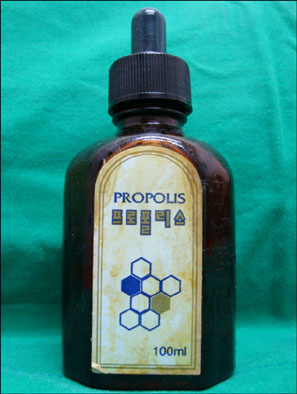Ann Dermatol.
2011 Feb;23(1):85-88. 10.5021/ad.2011.23.1.85.
Systemic Contact Dermatitis from Propolis Ingestion
- Affiliations
-
- 1Department of Dermatology, College of Medicine, The Catholic University of Korea, Seoul, Korea. drchos@yahoo.co.kr
- KMID: 2171960
- DOI: http://doi.org/10.5021/ad.2011.23.1.85
Abstract
- Propolis, also known as bee glue, is a substance collected by worker bees and it is used as a material for constructing and maintaining their beehives. It has been used topically and orally by humans for its anti-inflammatory properties. However, the growing use of propolis has been paralleled by reports of allergic contact dermatitis as a reaction to the substance. Contact dermatitis with generalized cutaneous manifestations elicited by propolis ingestion has not been previously reported. Here we report on the first case of systemic contact dermatitis from propolis ingestion in a 36-year-old woman.
MeSH Terms
Figure
Reference
-
1. Münstedt K, Hellner M, Hackethal A, Winter D, von Georgi R. Contact allergy to propolis in beekeepers. Allergol Immunopathol (Madr). 2007. 35:95–100.
Article2. Walgrave SE, Warshaw EM, Glesne LA. Allergic contact dermatitis from propolis. Dermatitis. 2005. 16:209–215.
Article3. Golder W. Propolis. The bee glue as presented by the Graeco-Roman literature. Wurzbg Medizinhist Mitt. 2004. 23:133–145.4. Lee SY, Lee DR, You CE, Park MY, Son SJ. Autosensitization dermatitis associated with propolis-induced allergic contact dermatitis. J Drugs Dermatol. 2006. 5:458–460.5. Kim JE, Shin H, Ro YS. A case of allergic contact dermatitis to propolis on the lips and oral mucosa. Korean J Dermatol. 2009. 47:199–202.6. Valsecchi R, Cainelli T. Dermatitis from propolis. Contact Dermatitis. 1984. 11:317.
Article7. Hausen BM, Evers P, Stuwe HT, Konig WA, Wollenweber E. Propolis allergy (IV). Studies with further sensitizers from propolis and constituents common to propolis, poplar buds and balsam of Peru. Contact Dermatitis. 1992. 26:34–44.
Article8. Giusti F, Miglietta R, Pepe P, Seidenari S. Sensitization to propolis in 1255 children undergoing patch testing. Contact Dermatitis. 2004. 51:255–258.
Article9. Nijhawan RI, Molenda M, Zirwas MJ, Jacob SE. Systemic contact dermatitis. Dermatol Clin. 2009. 27:355–364.
Article10. Veien NK. Ingested food in systemic allergic contact dermatitis. Clin Dermatol. 1997. 15:547–555.
Article
- Full Text Links
- Actions
-
Cited
- CITED
-
- Close
- Share
- Similar articles
-
- A Case of Allergic Contact Dermatitis to Propolis on the Lips and Oral Mucosa
- A Case of Allergic Contact Dermatitis by Propolis
- A Case of Allergic Contact Dermatitis due to Propolis Tincture
- A Case of Cerebral Infarction Following Ingestion of Urushiol
- Hematogenous Contct Dermatotos Due to Ingestion of Rhus: Report of a case





